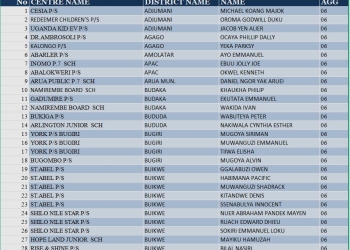KAMPALA, Uganda — The consumption of traditional, unregulated alcoholic beverages in Uganda, commonly known as artisanal illicit alcohol, increased to 71% of the total alcohol market in 2024, up from 69% in 2020. This is according to a new custom research report released Thursday by the Alcohol Industry Association of Uganda (UAIA).
The report, titled “Understanding illicit alcohol market in Uganda,” was researched and compiled by Euromonitor International. It was launched in Kampala with various industry stakeholders in attendance.
The research, conducted in the first quarter of this year, found that Ugandans on average consume 4.6 liters of pure illicit alcohol annually, compared to 2.3 liters of pure legal alcohol. This means illicit consumption is double that of legal alcohol. For context, 4.6 liters of pure alcohol is equivalent to about four 500ml cans of beer, four glasses of wine, or seven 30ml shots of vodka per week.
The UAIA commissioned the report to gain a better understanding of the illicit alcoholic drinks trade, its scope, size and impact on government revenue in Uganda, comparing it to 2020 data. The overall objective is to collaborate with the government to combat the issue.
“For about 10 years up to date, illicit alcohol has been accounting for 65% of the market to date; and the 35% of legal and regulated alcohol are paying over UGX 1Trillion in taxes,” said Emmanuel Njuki, UAIA Vice Chairperson, during his introductory remarks. “Government should be concerned about the revenue losses.”
Njuki added that tackling the illicit alcohol challenge would present a “better business opportunity” for both existing and new industry players, leading to increased tax revenue, improved public health and better returns on investment for the industry.
The report highlights that the total alcohol market in 2024 amounted to 15 trillion Ugandan shillings (approximately $4 billion), with 40% of this value attributed to illicit alcoholic beverages, totaling 6 trillion shillings (approximately $1.6 billion) in illicit sales. Factors such as unemployment and the rising cost of living have driven demand for cheaper, home-made artisanal alcohol like wines and spirits, which are up to 81% cheaper than legal alternatives. However, the report also noted a slight decrease in counterfeiting and smuggling/contraband alcohol from 2020-2024, shrinking from 27% to 25% and 4% to 3%, respectively.
In terms of volume, the report indicates that the total Ugandan alcohol market reached 1.7 million hectoliters in 2024, with 67.3% being illicit products, up from 64.5% in 2020.
Benjamin Rideout, a consultant who presented the report, explained that the illicit alcohol market expanded by 157,453 hectoliters between 2020 and 2024. The fiscal loss related to illicit alcohol sales grew at a Compound Annual Growth Rate of 16.2%, driven by increasing volumes and higher excise duties on various alcohol categories.
“Illicit alcohol is driven by affordability, accessibility, and low levels of enforcement,” Rideout stated, noting that with over 20% of Uganda’s population living below the national poverty line, affordability is paramount. He added that while illicit producers closely monitor legal market prices to maximize profits, especially with counterfeits, illicit beverages are priced “up to 81% lower than the equivalent legal beverages.”
Rideout also noted that consumers believed illicit alcohol was most widely available in Buganda (26%), West Nile (19%), Lango (19%) and Teso (13%), with 15% availability along the Eastern Border in Busoga.
The report identified significant tax leakage from the thriving illicit alcohol trade due to unregulated distilleries not declaring or misclassifying production, followed by counterfeit fabrication. The fiscal loss from counterfeit and illicit brands was valued at 3 trillion shillings (approximately $800 million) in 2024. However, only 10% of consumers associate illicit beverages with tax evasion or revenue loss for the government.
The UAIA recommends widespread public sensitization on the impact of illicit substances, not only on health but also on their broader societal implications, hoping for a behavioral shift in consumption patterns.
Isaac Arinaitwe, Principal Economist at the Finance Ministry, commended the UAIA study. He described the findings, particularly on fiscal loss, as “alarming” and pledged to work with the Euromonitor team to understand the report’s figures.
“Illicit alcohol even has a public health challenge to the consumers; it undermines fair competition to legitimate players,” Arinaitwe said. He suggested that while artisanal alcohol might be difficult to tackle, addressing counterfeits would require a holistic approach involving the Ministry of Local Government.
Abel Kagumire, Commissioner Executive Operations at the Uganda Revenue Authority (URA), confirmed the tax body has formed a working group to gather field intelligence on illicit trade in alcohol and tobacco.
Hon. Amos Kankunda, chairperson of Parliament’s finance committee, affirmed that increased budget allocation to URA and other relevant government agencies should lead to intensified enforcement. He added that the government is losing lives due to illicit alcohol consumption.
“In West Nile, we still have the challenge of illicit,” Kagumire said, noting that while Eastern Uganda has largely been managed, issues persist with ethanol claimed to be from Kenya but originating from Swaziland. “Identification of illicit products is still a challenge, unless the officers are trained in the field on how to identify them.”
Kagumire expressed surprise at the report’s findings, stating, “This report has unearthed areas where leakages have been, we have been collecting UGX 1 Trillion from the industry and we clap hands, but using this, we can even collect UGX 4 Trillion. As URA, we are surprised by the findings and we have taken them in good faith.”
The report also noted that counterfeit and smuggled alcohol shares slightly shrank between 2020-2024. Counterfeit alcohol thrives in both formal and informal outlets, while smuggled goods primarily originate from Kenya and DR Congo via porous land borders and Lake Victoria.
Key highlights from the report indicate that illicit alcohol sales represented 67% of the total alcohol market by volume and 40% by value in 2024, with illicit volume sales growing by 16% since 2020. Artisanal illicit alcohol, produced by rural households and small-scale informal distilleries, predominates in volume, while value sales mainly derive from counterfeit spirits. Fiscal losses, driven mostly by artisanal alcohol, grew by 80% since 2020, with counterfeiting being the second largest contributor due to diverted domestic ethanol production. Consumers are aware of illicit products’ illegality and health risks, but affordability remains the primary driver for consumption. Artisanal alcohol also holds significant cultural importance in traditional celebrations.




















